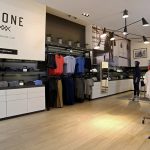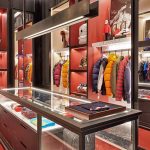Powered by a robust back-to-school (BTS) season and scant markdowns at its flagship Journeys chain, Genesco Inc. reported third-quarter earnings that came in well ahead of Wall Street’s targets and offered a bullish outlook for the year.
On a conference call with analysts, Mimi Vaughn, board chair, president and CEO, said the third quarter builds off “extremely strong first half of the year” with EPS “well exceeded our expectations, fueled by a very successful back-to-school selling season.”
She highlighted that sales showed a double-digit increase over pre-pandemic levels.
“We entered the pandemic in a position of strength, are navigating the pandemic well and will enter the post-pandemic phase even stronger,” said Vaughn. “While the current market conditions have presented a number of external challenges, including supply chain disruptions, labor shortages and wage increases, elevated freight expense, and other cost pressures, we are managing through them adeptly.”
Q3 Earnings Surpass Wall Street’s Targets
In the quarter ended October 30, earnings from continuing operations reached $32.9 million, or $2.26 a share, rebounding from pandemic-depressed earnings of $7.5 million, 52 cents, a year ago. EPS was 72.5 percent above the $1.31 recorded in the pre-pandemic 2019 third quarter and also well ahead of Wall Street’s consensus target of $1.29.
Revenues for the third quarter reached $601 million, up 25.5 percent from a year ago and 11.9 percent against the third quarter of 2019.
The 11.9 percent gain on a two-year basis reflects strong back-to-school sales and was driven by a 79 percent increase in e-commerce sales, increased wholesale sales, like-for-like store sales slightly above 2019 levels, and the positive impact of changes in foreign exchange rates.
By concept, sales year over year grew 20 percent at Journeys, 33 percent at Schuh, 69 percent at Johnston & Murphy and 6 percent at Licensed Brands. Compared to the third quarter of 2019, sales increases of 7 percent at Journeys, 29 percent at Schuh and 103 percent at Licensed Brands offset an 8 percent decrease in Johnston & Murphy sales.
On a year-over-year basis, Journeys and Schuh drove positive overall comps of 15 percent and 23 percent, respectively, while J&M comps were positive 77 percent.
Gross Margins Boosted by Reduced Markdowns
Third-quarter gross margin this year was 49.2 percent, up 210 basis points, compared with 47.1 percent last year and flat compared with two years ago. Although the increased e-commerce and wholesale mix, as well as freight and logistics, cost increases pressured gross margin comparison against the 2019 third quarter, this was mitigated by fewer markdowns at Journeys and Johnston & Murphy.
On a GAAP basis, S&A (selling and administrative) expense for the quarter decreased 220 basis points as a percent of sales compared with last year and decreased 240 basis points compared with the 2019 third quarter. Adjusted S&A expense decreased 250 basis points against 2020 and 260 basis points to 2019. The decrease from the 2019 third quarter is due primarily to reduced occupancy expense, along with selling salaries and depreciation, partially offset by increased marketing expenses. The reduction in occupancy expense is driven in part by rent abatement agreements with landlords and savings from government programs in Canada and the U.K.
Genesco’s GAAP operating income for the latest quarter was $43.8 million, or 7.3 percent of sales, compared with $8.2 million, or 1.7 percent, last year, and $25.9 million, or 4.8 percent, in the 2019 third quarter. Adjusted to exclude non-recurring items, operating income reached $45.2 million, or 7.5 percent of sales, a gain of 225 percent from $13.9 million, or 2.9 percent, last year; and 69.2 percent from $26.7 million, or 7.5 percent, in the 2019 third quarter.
Discussing highlights, Vaughn noted that sales during back-to-school at Journeys and Schuh exceeded pre-pandemic levels. She added, “While sales volumes typically moderate after the back-to-school rush, we were very encouraged that demand accelerated throughout the quarter and remained strong into October.”
In-person shopping recovered to drive to a 30 percent increase in-store sales over last year. Vaughn said although traffic is still below pre-pandemic levels, it improved across the board. Thanks to increased conversion, like-for-like store sales were up in the quarter for the first time since the pandemic began. Vaughn said, “These results reinforce our view that kids like to shop in person even if they begin their shopping journey online, making our stores a strategic asset working in tandem with our digital capabilities.”
Digital sales continued to expand despite the in-store recovery, increasing 11 percent year-over-year and 79 percent compared to fiscal ’20. Digital, which delivers double-digit operating margins, represents 18 percent of total retail sales and is approaching $500 million in annual sales.
Journeys Sees Fourth Consecutive Quarter Of Record Profitability
Elaborating on the performance of banners, Vaughn said Journeys achieved record third-quarter revenue and operating profit, marking the fourth consecutive quarter of record profitability even while operating with inventory almost 30 percent below pre-pandemic levels.
Vaughn said strong consumer demand for a variety of brands and styles drove continued momentum.
“The current fashion cycle, which I’ve been describing as shifting more into casual, plays into Journeys strength with a nicely diversified assortment,” said Vaughn. “However, for this back-to-school, performance was strong in several categories across both casual and fashion athletic.”
Nine of Journeys’ top 10 brands experienced year-over-year growth in the quarter. In addition, in-person back-to-school selling drove a big pickup in non-footwear sales, like backpacks, with non-footwear up over 50 percent.
With consumers willing to spend more for full-priced items, coupled with higher footwear ASPs, Journeys also experienced a nice lift in gross margins.
Digital sales held on to most of last year’s strong gains as Journeys increased social media and digital advertising, driving an almost 30 percent increase in online conversion versus two-year-ago results.
Said Vaughn, “Recent market research validated that our strategies are further building the strength of the Journeys brand as Journeys share of teen footwear purchases and likelihood to be considered as a go-to place for shoes have both increased nicely since the last time the research was conducted.”
Schuh Boosted By Strong Back-To-School
Schuh’s Q3 constant-currency sales increased almost 20 percent above pre-pandemic sales, boosted by back-to-school selling.
Although students attended school in person last year, this year, shoppers increasingly return to physical retail with higher conversion and more multi-sales seen. Online sales saw “large gains” on top of last year’s meaningful growth as the e-commerce channel more than doubled on a two-year basis, fueled by several back-to-school marketing campaigns.
“The fashion trends driving Schuh’s business are largely the same ones driving Journeys, and several of Schuh’s top 10 brands experienced growth in the quarter as well,” said Vaughn. “Additionally, Schuh’s success managing through COVID strengthened its key vendor partnerships, boding well for the future with even better access to products.”
Johnston & Murphy Helped By Casual Push
Johnston & Murphy’s efforts to bring in more casual offerings for a “more comfortable post-pandemic environment” helped the chain track well ahead of its turnaround goals in the quarter. Both online and in-store sales are still below two-year-ago levels due to the extended delays of return to the office and lower inventories from supply chain disruption but continued to show incremental improvement. J&M’s inventory is almost 50 percent below two-year-ago levels.
J&M’s apparel business, highlighted by printed woven shirts and knits, increased by over 30 percent versus two years ago.
Licensed Brands faced the biggest challenges from supply chain disruption that led to much higher-than-expected freight costs. On a positive note, strong demand was seen for both Levi’s and Dockers footwear in value and full-price channels, which positions the business for improved profitability as supply challenges subside, according to Vaughn.
Looking ahead, November sales are tracking “nicely ahead of pre-pandemic levels, and the boot season is off to a good start with boots as a key part of our fourth quarter mix,” said Vaughn.
Inventories at the quarter’s close decreased 8 percent year-over-year and were down 28 percent from two years ago. Said Vaughn, “While supply chain issues will continue to require close management, we have taken many actions to best prepare our businesses to meet our holiday sales expectations.”
Genesco provided guidance for the year after suspending the practice for a number of quarters due to uncertainties created by the pandemic.
Genesco’s outlook calls for:
- Sales in 2021 to be up 9 percent to 11 percent, compared to Fiscal 2020.
- Adjusted EPS from continuing operations in 2021 in the range of $6.40 to $6.90, representing growth of approximately 45 percent at the mid-point compared to 2019.
- Implicit in the annual guidance is an expectation for Q4 sales growth year over year at the midpoint to be in the mid-single digits. Q4 adjusted EPS is expected to range from $2.22 to $2.72, which compares to $2.76 a year ago and $3.09 in the 2019 fourth quarter.
Photos courtesy Genesco/Journey’s
















